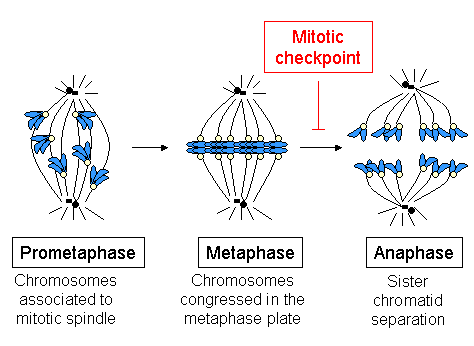Structural Biochemistry/Bub1 and BubR1
[[wide image:Spindle chromosomes-en.png thumb Spindle chromosomes-en |thumbnail| ]]
BUB1 and BUBR1
]]
BUB1 and BUBR1
The BUB1 and BUBR1 are the two kinases involved in the checkpoint during mitosis. As seen in the picture, before the two sister chromatids separate in anaphase to create chromatids of two cells, the checkpoint is to ensure that they are separated accurately. This checkpoint is necessary to avoid mutations where cells do not divide which can cause aneuploidy. Aneuploidy results when there is an abnormality in the is number of chromosomes in a human embryo. One of the most well known conditions is Down Syndrome where there is a mutation in the chromosome 21 of a human. The sister chromatids do not separate resulting in a third copy present in the embryo.
The spindle assembly checkpoint is the regulatory checkpoint that allows a dividing cell to continue its division process if everything is going according to planned and the chromosomes align properly along the metaphase plate and attach to microtubules via kinetochores at each of the centromeres. It is essential because if the chromosomes in a cell that is undergoing mitosis do not align and separate correctly, one daughter cell will get two copies of a chromosome, while the other daughter cell completely lacks that same chromosome. This is the cause of many defects in newborns. It is also seen in over 90% of solid tumors. Many different problems arise from incorrect chromosome splitting, depending on the certain chromosomes that does not separate correctly.

There are two kinases which play central roles in the spindle assembly checkpoint that occurs during metaphase in mitosis that we will discuss, even though there are at least fifteen proteins involved in this process altogether. Kinases are enzymatic proteins that transfer phosphate groups from high energy donors, to lower energy acceptors. The two that are highly involved in the checkpoint are BUB1, which stands for budding uninhibited by benzimidazole 1, and BUBR1, which stands for budding uninhibited by benzimidazole-related 1, also called BUB1B. These two proteins, BUB1 and BUBR1, are very similar, due to the fact that they are paralogs, meaning they came from the same ancestor and evolved to slightly different proteins. /but even for paralogs these two share many common attributes and their amino acid composition is basically the same, yet they perform different functions. This is due to the difference in their structures.
In regards to BUB1, it undergoes phosphorylation, the addition of a phosphate group. By doing so, it abolishes the CDC20 gene in order to stop SAC and put a pause to mitosis. This phosphorylation as well as that done by BUBR1 have yielded a few hypothesis and are still in research.
UB1 catalytic activity is of paramount importance because BUB1-mediated CDC20 phosphorylation inhibits APC/C–CDC20 in human cells

Both of these enzymes have three main regions in them, an N terminal region and two C regions, one of which is terminal and another that is intermediate. These different regions are involved in different steps, such as spindle checkpoint on one terminus and chromosome congregation on the other. There are several differences in these region in each of the two molecules. The importance of the C region is seen to be insignificant as compared to the N terminal in BUBR1 due to the lack of the C terminus by the Mad3. Mad3, mitotic-arrest deficient, replaces the BUBR1 in in yeast, worms and plants. The Mad3 does not have a C region and since no animals have both BUBR1 and Mad3, the functions of the Mad3 remain the same without the presence of the C region.
BUB1
BUB1 is bound to the kinetochores at it's N-Terminus region. Both BUB1 and BUBR1 contain KEN boxes, which are protein motifs that mediate protein recognition. Two KEN boxes, are located in the N-terminus of BUB1 that are involved in and required for the phosphorylation of CDC20. CDC20 phosphorylation is one of the main tasks of BUB1, which first phosphorylates BUB3 then along with the help of BUB3, it phosphorylates Cdc20. It also plays many other major roles. One of these is the recruitment of BUBR1, Mad1 and Mad2. Upon spindle damage BUB1 is also triggered to phosphorylate Mad1. This kinase is also highly involved in the organization of the centromere.
BUBR1
BubR1 has many roles as well and contains KEN boxes that it depends on to function properly too. It helps connect kinetochores to microtubules and keep the attachment stable. It regulates mitosis by inhibiting anaphase when chromosome segregation is incomplete or incorrect. It also regulates prophase one during meiosis one in eggs.
Effects of Bub1 and BubR1
-Loss of BUB1 can result in aneuploidy, which is the abnormal number of chromosomes resulting from faulty mitosis. Aneuploidy is seen in about 90% of solid tumors.
-Deletion of Bub1 in some species increases the rate of incorrect chromosome segregation while in other species it results in slow growth and loss of chromosomes.
-Many forms of cancer have been related to cell with improper spindle checkpoints
Sources
BUB1 and BUBR1: multifaceted kinases of the cell cycle Victor M. Bolanos-Garcia, Tom L. Blundell
This image is a derivative work of the following images: File:Spindle_chromosomes.png licensed with Cc-by-sa-3.0,2.5,2.0,1.0, GFDL
"Spindle checkpoint." Wikipedia. 7 December 2012. 7 December. 2012 <http://en.wikipedia.org/wiki/Spindle_checkpoint#Metaphase_to_Anaphase_Transition>.